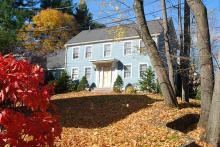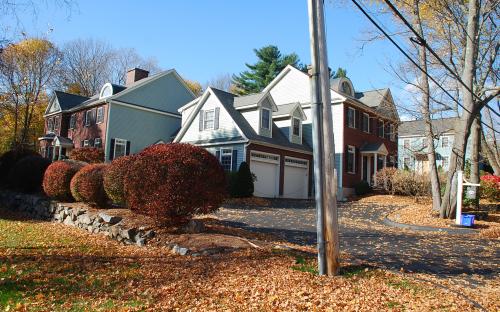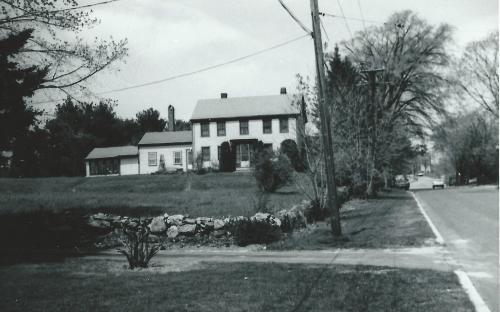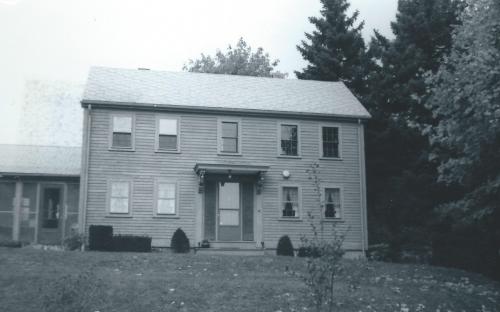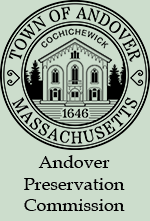Architectural Description:
NRDIS; 3 irregular chimneys, 2 stories with ell and shed, side gable end facade, front center entrance, identical regular windows (altered to 2/2).
Federal - Greek Revival
Historical Narrative:
Themes: Architecture and Community Development
One of the few original Frye Village homes not acquired by Mr. William Madison Wood when he built Shawsheen Village, a model community for employees of American Woolen Company in the 1920's. See Form A.
The deed of Timothy Foster to Ebenezer K. Morrill on July 31, 1843, list a lot of land 110 rods for $140. Ebenezer took a $450 loan from Nathaniel Berry on April 26, 1843, and the deed states with buildings. Ebenezer K. Morrill was from Salem, a Cordwainer, who married Hannah Towne in Aug. 1831 at West Parish Church. Ebenezer took a loan of $125 from Daniel Abbot & Timothy Foster on Nov. 24, 1844, on the property with buildings. The loan was paid off on Jan. 25, 1848. The 1850 Valuation Schedule lists E.K. Morrill, West Parish, with 1 acre of land & Dwelling house $950.
Ebenezer took another loan of $200 from John Johnson and William Foster on March 7, 1851 but defaulted in 1853 the Johnson & Foster took possession of the property. They later sold the house to James Byers Jr., a Machinist at the Smith & Dove Manuf. Co. James was born in 1829 in Scotland, son of James & Mary B. (Smith) Byers. His mother was the sister of John & Peter Smith. James married on Nov. 24, 1852 in Ipswich, MA to Susan Abbott Underhill b. Aug. 26, 1832, dau. of Oliver & Caroline (Parkhurst) Underhill. James & Susan had two sons James E. b. Nov. 22, 1854 and Oliver B. b. July 17, 1859. Sadly Oliver died on May 27, 1860 of consumption, just 10 months old. James died that December on the 28th also of consumption. Three months after son James W. died on Mar. 13, 1861 of Croup. Widow Susan A. Byers then sold the home to Joseph W. Poor on Oct. 9, 1865. Susan returned to Ipswich, later remarried to Henry C. Kendrick in Jan. 1873 and had a daughter Elizabeth.
The Poor family, who owned a very successful carriage and wagon shop at Frye Village, were involved in the abolitionist movement and underground railway in 1840's and beyond. .Joseph W. Poor was the son of William Poor and descendant of Daniel Poor, one of the original settlers of Town of Andover.
Joseph's father William Poor was born in the North Parish of Andover on October 12, 1805 and died on December 30, 1898 living for 65 of those years in Frye Village in his home across the street from his business at 77 North Main Street. William was the son of Joseph & Mary (Bradley) Poor and the fourth child of eleven. At age 21 William took up the trade of wheelwright becoming an apprentice with his maternal grandfather George Bradley of the North Parish in Andover. It was under Bradley’s skillful direction that Poor soon became an expert wagon maker. William first went to work in Methuen and was living there when he married on May 14, 1829 to Hannah Gleason White of Andover. William & Hannah would have four children; Martha, Julia, Joseph W. and Charles.
In 1833 William settled in Frye Village and opened his blacksmith shop on North Main Street. The wagon shops were approximately where the First Christian Church Scientist is located today. It is said that the “first steel-backed scythe was hand forged by this gentleman.”
In 1838 William’s younger brother Jonathan Poor joined in the work as wheelwright. In 1846 William’s son Joseph W. Poor joined his father’s business at age 16. The youngest son Charles H. also worked for many years as a general helper in the family business. By 1850 the business was well established and included a Wheelwright shop, Blacksmith shop, Lumber house, Carriage house, fixtures and land valued at $1400. The Andover Advertiser, May 31, 1867 pg. 2, "William Poor purchased land of Mrs. Lucretia Richardson, adjoining his shop in Frye Village and is about to erect a building 32’ x 42’, two and a half stories, for the painting and blacksmithing branches of this carriage manufactory….This building is the only surviving structure of the Poor Wagon Works.
The wagon company was well patronized throughout New England and William was considered “the best wagon builder in the state.” His honestly, craftsmanship, and reputation for a quality product, especially butcher carts, brought many clients. “Among the most famous being a missionary’s cart which was sent to Turkey and scores of wagons specially designed and sent to Oregon in the pioneer days of that state, from 1856 to 1862.”
William Poor was an abolitionist, as were his family, and their homes and business have been linked to the Underground Railroad as safe stations for fleeing slaves headed north to Canada. The Poor family were members of the Free Christian Church in Andover. On May 4, 1869 William’s wife Hannah died and the following year he remarried to Hannah Holt.
Andover Advertiser Dec. 12, 1884, p2 – "William Poor has built a new flume and put a turbine wheel into his wagon manufacturing at Frye Village. The wheel is 12 inches in diameter and takes the place of a wooden one just sixteen times as large." In 1895 at the age of 90 William retired and handed over the reins of the business to his son Joseph W. Poor.
Joseph W. Poor was born July 22, 1830 in Methuen, MA. Joseph was educated in the public schools of Andover and Phillips Academy leaving at age 16 to join his father as a wagon builder. “He developed a rare genius for mechanics, mastered the blacksmithing trade and was known for his craftsmanship skills and ingenuity of working through the details.”
Joseph married in 1857 to Abby Minerva Reynolds of North Andover and they also had four children, Wm. George, Minnie, Lincoln and Ray. Joseph was also an active member in Andover’s fire department and for many years served as chief engineer of the engine company. Joseph purchased this property on Oct. 9, 1865, at the end of the Civil War, from Susan A. Byers. Joseph’s health began to decline, and he deeded his home property to wife Abby M. on Dec. 27, 1893.
Andover Townsman (AT); Jan. 29, 1897, p1 - Wagon Shops Still Running – Poor’s Wagon shops at Frye Village are still open for business, notwithstanding the report to the contrary, that someone seems to have industriously circulated. Mr. Poor is quite ill at home, but the old and reliable employees are still at work and have been this week re-enforced by the return of Andrew Parsons well known in Andover as one of the best wood workers on wagon-work in the country, and who was for a long time in charge of the department at the Frye Village Shops. Mr. Parsons will remain for a while, and patrons of the old business may be sure of being well cared for notwithstanding Mr. Poor’s enforced absence.
Apr. 17, 1897, AT p1 - James L. Wallace of Merrimack is the new wheelwright and T. J. Goodwin the blacksmith at the wagon works at J. W. Poor’s in Frye Village. Business is booming at this old and well-known manufactory and with the returning health and strength Mr. Poor expects a flattering years’ business.
June 4, 1897, AT p1 “A New Firm of Wagon Builders.” Joseph W. Poor retires sells wagon works to H. B. P. Tuttle & John Morrison of Merrimac, MA.
Joseph’s health forced his retirement at age 67 in June 1897, and the old Poor Wagon Works sign came down after 64 years at this location. Joseph & Abby had been married for 53 years before Joseph died on April 6, 1910. The Poor family are interred in Ridgewood Cemetery in North Andover.
Abby M. Poor remained in the home then sold to Barbara C. Morrissey, wife of William. B. Morrissey on June 21, 1917. After William died Barbara placed the deed in both her and Margaret S. Morrissey's name on Feb. 14, 1950. Margaret S. Morrissey later inherited the estate and sold to J. Peter & Susan L. McCracken on May 23, 1969.
Two year later Robert R. & Betty J. Deacon purchased the property on Sept. 14, 1971. Bob Deacon was a teacher in the Andover Public Schools. He graduated from Massachusetts College of Art BFa and MA from Salem Sate College. He taught Art at Andover Jr. High from 1961-1968 then transferred to West Junior High was a guidance counselor until his retirement. Bob was also a skilled carpenter and did a great deal of restoration on the house. The Deacons sold the house Jorge A. & Susan C. Schwarz on Nov. 13, 1991.
Jorge and Susan owned for six years then selling to Mark Conserva on Mar. 25, 1997. The long front lawn facing south would later be developed along with the Poor Home and is now part of the Sixty Six Poor Street Condominiums in Mar. 9, 1999. The home remains but the small barn just west of the house was later razed.
Bibliography/References:
Essex County Registry Deeds, Salem MA
Essex Northern Registry Deeds, Lawrence, MA
See Form A
Andover Historical Society files
Seibert, Wilbur Henry: "Andover Underground Traffic" The Underground Railroad in Mass. Worcester: Antiquarian Soc. 1936, p.29-31
Owners;
Ebenezer K. Morrill
Timothy Foster - Jan. 24, 1843 - b. 336 leaf 238 - $140
Ebenezer K. Morrill, wife Hannah - July 31, 1843 - b. 338 leaf 74 - $140
Morrill to Nathan Berry - April 26, 1843 - b. 338 leaf 60 $450 mtg. loan. land w/blds.
Morrill to Daniel Abbot & Timothy Foster - Nov 29, 1844 - b. 342 leaf 12 mtg.
Ebenezer K. Morrill - Jan. 25, 1848 - b. 392 leaf 150 - discharge
Morrill to John Johnson & William Foster - Mar. 7, 1851 - b. 441 leaf 229 - mtg.
John Johnson & William Foster - Aug. 22, 1853 - b. 482 leaf 40 poss.
James Byers Jr., wife Susan A. - Mar. 7, 1857 - b. 547 leaf 267 - $1000
James Byers Jr., estate, widow Susan A. Byers heir - 1865
Joseph W. Poor - Oct. 9, 1865 - b. 690 leaf 138 - $1050 - 100 sq. rds. w/dwelling
Abby M. Poor, wife of Joseph W. Poor - Dec. 27, 1893 - b. 129 p. 311
Barbara C. Morrissey, widow of Wm. B. Morrissey - June 21, 1917 - b. 377 p. 252
Barbara C. Morrissey and Margaret S. Morrissey - Feb. 14, 1950 - b. 732 p. 499
Barbara C. Morrissey estate, Margaret S. Morrissey heir -
J. Peter & Susan L. McCracken - May 23, 1969 - b. 1131 p. 91
Robert R. & Betty J. Deacon - Sept. 14, 1971 - b. 1179 p. 236
Jorge A. & Susan C. Schwarz - Nov. 13, 1991 - b. 3346 p. 238
Mark Conserva - Mar. 25, 1997 - Mar. 25, 1997 - b. 4725 p. 223
Sixty Six Poor Street Condominium - Mar. 9, 1999 - b. 5367 p. 60 (p. 161)
Stephen & Christine C. Kalman - Mar. 9, 1999 - b. 5367 p. 121
Dominick Silvestri & Susan A. Krenerezley - Oct. 21, 2008 - b. 11,354 p. 48
Inventory Data:
| Street | Poor St |
| Place | Shawsheen Village |
| Historic District | Shawsheen Village NRH District |
| Historic Name | Joseph Poor House |
| Present Use | residence |
| Original Use | residence |
| Construction Date | 1843 |
| Source | ERDS, ENRDL, 1830 map |
| Architectural Style | Federal |
| Foundation | stone |
| Wall/Trim | clapboard |
| Roof | ridge |
| Outbuildings / Secondary Structures | garage |
| Major Alterations | remodeled pool 1970 |
| Condition | Excellent |
| Acreage | 33' from street, 210' frontage on street |
| Setting | Residential |
| Map and parcel | 52-94 |
| MHC Number | ANV.440 |
| Recorded by | Stack/Mofford, James Batchelder |
| Organization | Andover Historical Society - Andover Preservation Commission |
| Date entered | 1968/1975-77, 6/2/2015 |
